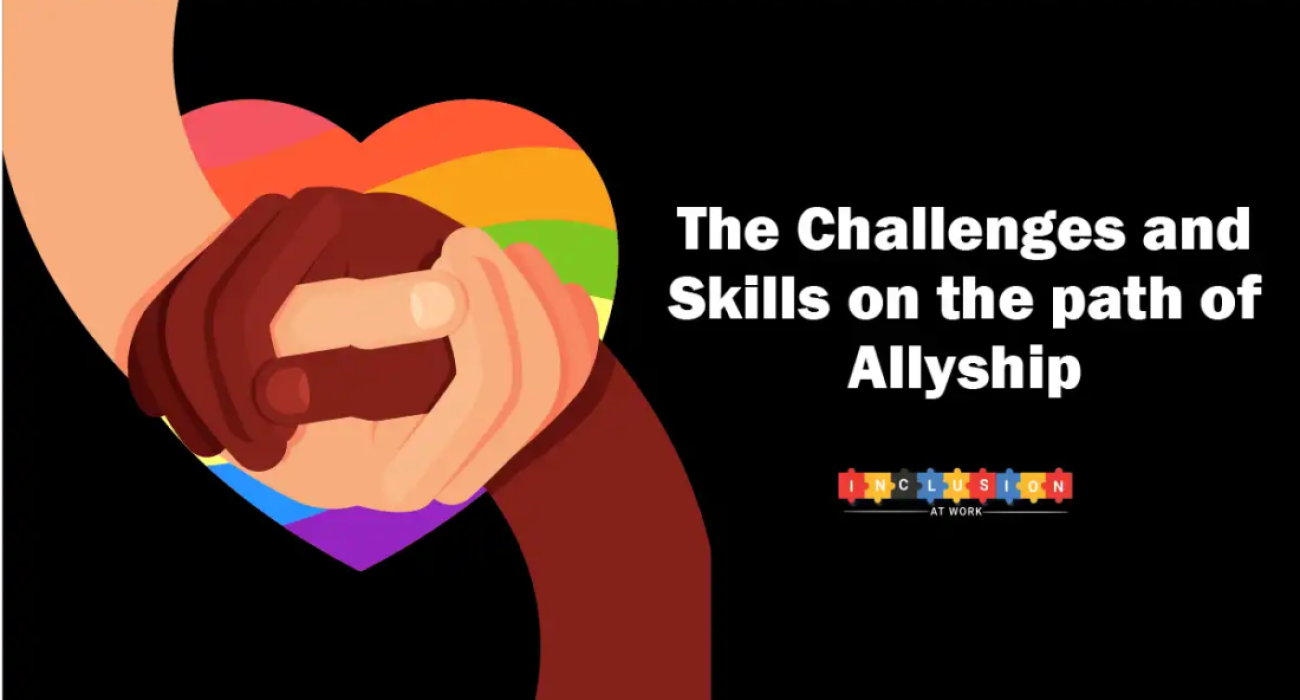

We at, Inclusion at Work, an Equilibrio Advisory vertical, recently concluded the first Level of our DEIB Certification Course, In This Together. In our mentoring session our cohort unpacked the different facets of allyship and how to navigate the journey of being an ally. Our focus for the first level had been the marginalized communities vis-à-vis Gender and Sexuality. We delved into understanding the unique intersections and lived realities within the LGBTQIA+ community.
Our cohort brought up interesting questions and showcased necessary skills needed to take up an allyship while sharing their doubts and real-life exchanges in trying to embody the role of an ally.
We bring to you some takeaways from this stimulating session; as our cohort unpacked some of the very practical challenges one can encounter while they are starting on the path to allyship, and what are some necessary skills one can cultivate as an ally to the LGBTQIA+ community.
Table of Contents
ToggleAs an ally one must field a plethora of questions regarding the marginalized community they are advocating for. Often these questions can arise from a space of unconscious bias. In the case of LGBTQIA+ advocates these questions can look like:
“What would you do if your child was gay?”
“Why do they need to have flashy Pride parades?”
“Why do queer couples have to advertise their relationships in public?”
“What is the need for he/she/they pronouns?”
In our mentoring session we spotlighted an interesting tenet of trauma-informed approach, “assume good intentions”. Using this lens a facilitator/ally presumes that all questions or assumptions come from a genuine place that is aligned with an individual’s personal frame of reference, without an active intention to cause harm.
As an ally one needs an understanding of the larger systemic issues that lead to such questions. Most of these questions come from a genuine space of having existed in a cis-heteronormative world where being cisgender and heterosexual is still considered the norm.
Where a bias is evident, an important skill for the ally then is to come from a place of curiosity, instead of irritation or aggression and probing what are the worldviews that have led to these beliefs. This is where an important aspect of allyship surfaces: to challenge prevalent norms and structures. However, for unconscious bias to be truly resolved a person would require psychological safety. While questioning the long-held beliefs/views of another person, the ally should come from a place of compassion instead of hostility.
Often while doing advocacy work the ally can see microaggressions coming to the fore, be that in their workplace or family or peer groups.
For example, when a person is alienating a minority group by using the phrase “these people” to signify persons belonging to the group. In this case, it is important for the ally to locate this tendency as a natural reflection of inherent affinity or contrast bias, that looks at people different than the self as foreign.
To avoid frustration, an ally should locate microaggressions outside the person, in the larger systems and cultural conditioning whose product the person is. Any discriminatory behavior including microaggressions, arises from a cognitive bias that needs to be addressed. Keeping this understanding in sight, qualities like patience, and kindness become integral tools for the ally to work with.
To help those who are still looking at marginalized people from a lens of unconscious bias, the ally can spotlight examples of lived experience, highlighting the challenges systemic barriers can create; they can draw parallels to familiar groups or contexts to explain their ideas. For example, they can use another accepted social movement like the feminist movement to draw similarities with the demands of queer and trans communities, thereby anchoring the need for basic human rights and equity of all persons. Using these tools, they can probe the assumptions that come from a place of cis-heteronormativity and unravel them gently.
Allyship becomes even more necessary when one is working in a rural grassroots level outside the urban bubble. It might seem difficult to explain ideas to another person who does not share a basic context with the ally.
To begin with, an ally must be very clear in their own understanding of the marginalized group they are seeking to uphold. An ally should be educated about the socio-historic oppression of the marginalized group, the challenges they face, and from that space exhort the said community’s right to occupy space with dignity.
Allyship is based in creating spaces of solidarity and changing predominant narratives that are often mired in negative stereotypes and misinformation. The labor of educating others about their own marginalization can take a toll on minority groups, so an ally can alleviate that load by continuing these conversations.
These conversations might be uncomfortable to begin, so a crucial piece of allyship then becomes learning to move through discomfort. Because these conversations have the power to create visibility and normalize things that were once stigmatized.
For instance, when talking to children about concepts of queerness or trans lives, it is necessary to break down complex frameworks into simple relatable bits. It can be helpful to bring in narrative elements in such scenarios and tapping into universal emotions like the need to belong and make connections.
Often resisting oppressive systems and creating space for marginalized groups can be challenging work. Having uncomfortable conversations, unlearning one’s own inherent biases, learning about the histories of loss and marginalization and challenging systemic bias and dismantling structural barriers can lead to overwhelm and burn-out. It can cause mental health concerns like anxiety, fatigue and depression.
A sustainable path to allyship must be rooted in self-introspection and emotional intelligence. To be an ally in the long-term one has to simultaneously cultivate skills like active listening and self-compassion. To achieve this learning the skills of emotional regulation and creating safe boundaries becomes a crucial step.
Allyship can go a long way in creating inclusive and equitable structures, however it is equally necessary for a budding ally to remember they cannot take responsibility for the behaviors and reactions of others. It’s about knowing when to engage in a conversation, and when to step back. It is also important for an ally to instill humility, and realize they may not know all the facts, and it is okay for them to take a pause and regroup. It would be helpful for allies to remember allyship is not about never making mistakes, but about learning/unlearning from their mistakes.
While looking at the various challenges and skills on the path of allyship we tried to conclude with the grounding truth that allyship is about incremental growth. Change might not be immediate. It might be unrealistic to expect to change someone’s worldview with one conversation, or change larger structures with one protest march or workshop. Rather change will be gradual and be built through many such endeavors to create spaces of safety and solidarity. The path of allyship is a life-long commitment and as allies we need to look at our DEIB praxis from a similar lens.
Transcribed by Usri Basistha
IAW resources
Browse our help directory